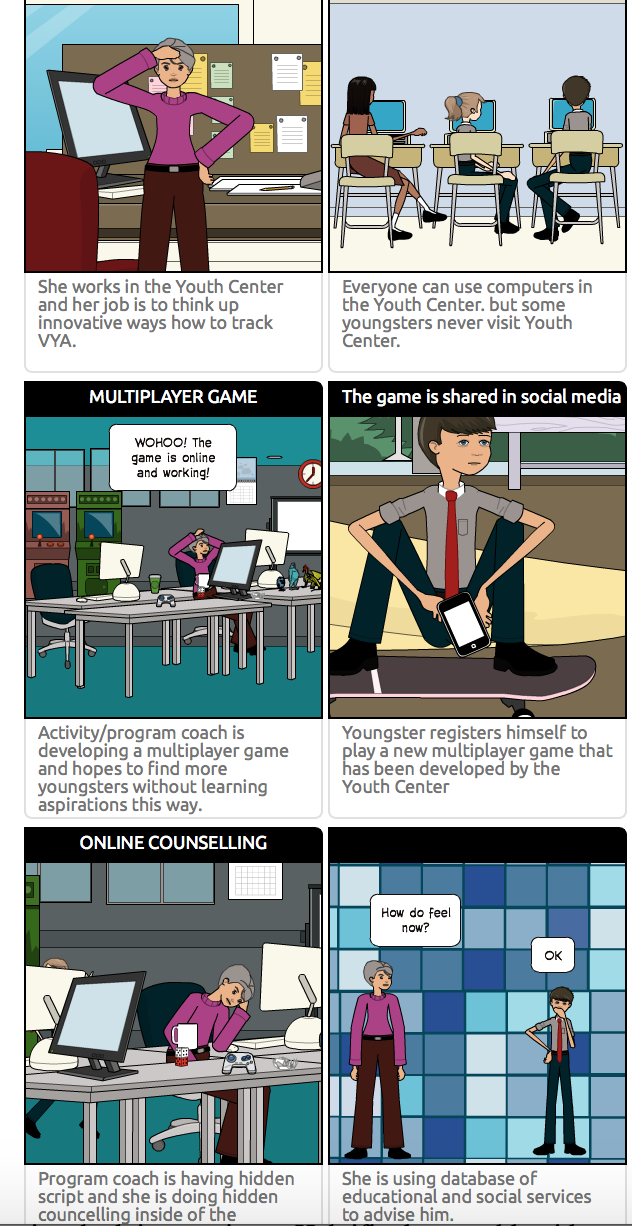One goal of the EduMAP project has been to develop better adult education access strategies for young vulnerable adults using social media. The initial intention in the project proposal was to develop social media based forums to increase the young adults’ access to information about relevant adult education opportunities. However, as the project partners were making interviews around best practice cases and with different groups of young vulnerable adults using the communicative ecologies approach, it became evident, that young adults without aspirations and aims and with difficult cultural and educational or migrant backgrounds rarely used social media as a channel to directly search for information about adult education opportunities. Rather, mediated approaches were used where different advisors, e.g. people from personal Whatsapp networks, were directing young people towards finding suitable educational courses.
The project team from Estonia analyzed the case studies from communicative ecologies of young vulnerable adults using the interaction pattern mapping approach with concept maps depicting the assemblages in communicative ecologies. Concept maps were drawn from each case study and finally a generalized concept map depicting interaction possibilities around accessing adult education was composed.
We held a workshop together with project partners from the UK and Finland to explore these interaction patterns of accessing adult education opportunities. One of the guests in this workshop was Zsolt Bugarski, a social entrepreneur and lecturer of social work at Tallinn University – he acted as the expert of voluntary help networks and introduced us how a support network “Helpific” for help offers and help requests works to help vulnerable people. Our initial intention was that we could add one more educational advice service to Helpific that would guide young vulnerable people towards suitable educational opportunities. This would have helped us to quickly scale up our educational help service using social media channel based Helpific, a network that has 6000 members in different European countries.
Interesting from our project goals’ perspective was that Helpific had already tested out the advisor-mediated access to social support networks, which also seemed the best working scenario in the EduMAP case studies. Yet, since Helpific’s code was closed and we needed to develop an open source solution in the project, we had to drop the idea of using their platform and thereby gaining access to a wide international community of users. It was clear to us from the observed interaction scenarios that the more central approach of offering such social media-based help forums would be more useful than help provided at each vocational school or adult education provider.
Based on our analysis, it seemed useful offering guidance towards adult education opportunities around youth centres, refugee centres and other associations where a payed adviser role was present. The time-scope of the EduMAP project’s activities did not allow us to engage with such centres internationally in participatory design workshops and technology development. Also, each country had a particular system how the guidance to adult education was provided, so we could not launch any universal forum for the purpose of mediating between different vulnerable young adults and the adult education providers. Finally, the cold start of such systems is not possible; developing user communities, adopting systems in each country to their needs requires longer time-scope than the EduMAP project had. Therefore, we decided to take another path in the forum development and proposed a set of action scenarios about using social media for bringing young adults to educational opportunities.
These scenarios were developed as comics. They can be viewed at:
Social facilitator: https://www.pixton.com/schools/storyboard/3epp70kk
Hidden advisor: https://www.pixton.com/schools/storyboard/97ek6mj1
Special educational needs: https://Pixton.com/ic:4iqo27t4
Course embedded to cultural settings: https://www.pixton.com/schools/storyboard/ja6n1tcb
Alumni network: https://Pixton.com/ic:xjixt5am
Communication across social media: https://Pixton.com/ic:e6ieff80
We ask different stakeholders as well as the readers of this post to provide feedback to the 6 general scenarios. Particularly we seek information about how these scenarios of supporting young vulnerable adults to access adult education would work in the context of European countries. The survey with the comics of the scenarios may be found here: http://www.connect.ee/survey/407996405/
The survey is open during December 2018. Adult educators, advisors, policy makers and young people are invited to give feedback. Based on the feedback the set of interaction scenarios will be finalized to be used as guidance by adult education providers in different countries to develop technical solutions for spreading adult education opportunities among young vulnerable adults.
Kai Pata
Docent, Tallinn University, School of Digital technologies



Comments